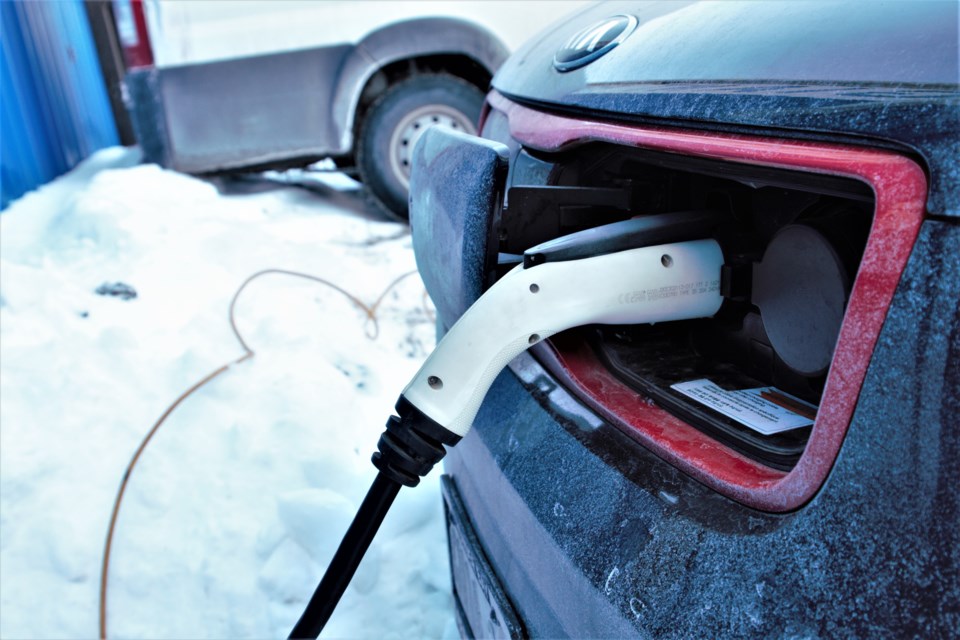THUNDER BAY – Thunder Bay residents are likely to notice more electric vehicle charging stations popping up around the city in the coming months.
A program known as Plug In Thunder Bay, which is expected to triple the number of local charging stations from 42 to over 130, should be largely implemented by the end of 2022, according to the Thunder Bay Community Economic Development Commission (CEDC).
CEO Eric Zakrewski shared the news on Friday at a funding announcement at the Sleeping Giant Brewery alongside Thunder Bay-Superior North MP Patty Hajdu, although the program and funding details were already reported last year.
The CEDC is administering the program with $500,000 in federal funds, covering up to 50 per cent of costs for successful applicants to purchase and install the devices, which allow a typical EV to recharge to 80 per cent within about half an hour.
The stations will be installed in some public spaces including Lakehead University and medical clinics, as well as private and semi-private locations like apartments, small businesses, restaurants, and auto dealerships.
While some stations purchased with the aid of public funds won’t be publicly accessible, Zakrewski said they’ll still bring value to the community.
Supporting apartment owners in purchasing the stations, for example, will make the buildings more accessible to EV owners, he said.
“Some of these apartment buildings may have 40 or 50 units. For them to get two or three charging stations, it allows the owners of those buildings to be more progressive in marketing to future tenants who own an EV. If you have nowhere to plug it in, how are you going to live there?”
The CEDC will produce a map showing charging station locations as they’re installed between now and March of 2023. Zakrewski said he expects most to be in place before the end of this year.
It’s hoped that expanding the number of charging stations will “increase consumers' confidence so that they can look at transitioning from internal combustion engine cars to electric vehicles,” he said.
The cost of EVs remains a sticking point for many, despite a $5,000 federal incentive for those who buy electric. But Hajdu said the availability of charging stations is another important factor in whether people are willing to make the leap.
“I think there’s a real interest in electrification,” she said. “People are looking at how they transition to an electric vehicle. There are a number of barriers, costs being one of them… and then the other challenge is the fear that if you’re out and about, you won’t have a place to recharge your vehicle.”
A 2020 study published in the journal Nature Energy suggested up to 20 per cent of those who purchase zero-emission vehicles later went back to gas-fueled cars over the inconvenience of accessing chargers.
On the other hand, many EV owners point to benefits like big fuel savings and a vastly reduced carbon footprint, with transportation accounting for roughly a quarter of Canada’s emissions.
In last year's election, the Liberals committed to spend $700 million to create 50,000 new EV and fuel cell vehicle chargers, above an existing commitment of $180 million. Canada has an estimated 15,000 charging stations already available to the public.
Advocates and auto industry players have said those investments will still fall far short, if the government is serious about its targets requiring half of new light vehicle sales to be zero emission by 2030, ramping up to 100 per cent by 2035.
Currently, EVs make up only about 4 per cent of Canadian vehicle sales. A 2020 study commissioned by Transport Canada found only 33 per cent of car dealerships had even a single EV in their lots.
Hajdu said it will be challenging for her government to meet its targets, adding supply chain challenges during the pandemic could set them back.
“I think there are a lot of factors that go into being able to reach that [target that are] not exclusively in the control of the government,” she said. “Obviously we’re seeing shortages right now, supply chain challenges. So there may be things that impact our ability, but I think it’s a sincere goal, it’s an ambitious goal, and I think the investments we’re making… will help us reach it.”
There's also a role for provinces on the issue, Hajdu said, taking the opportunity to point out the Ford government’s cancellation of Ontario’s EV purchase incentive in 2018.
Provinces that have implemented significant incentives, like Quebec and B.C., have seen far better uptake in EV sales.
“We’re hoping provincial governments will continue to examine providing incentives like that, because of course, these vehicles are still expensive, comparatively,” said Hajdu.
Zakrewski said the private sector is increasingly bought in to the idea that EVs represent the future, if not the present.
“We really think this is just going to be the tip of the iceberg in terms of private investment for this,” he said. “As these stations get installed, as contractors become familiar with the technology, we think there will be more and more interest as they start to show up around town."
"We had more people apply for dollars than were available, which is a great sign it’s on peoples’ minds and they’re thinking about those investments.”
